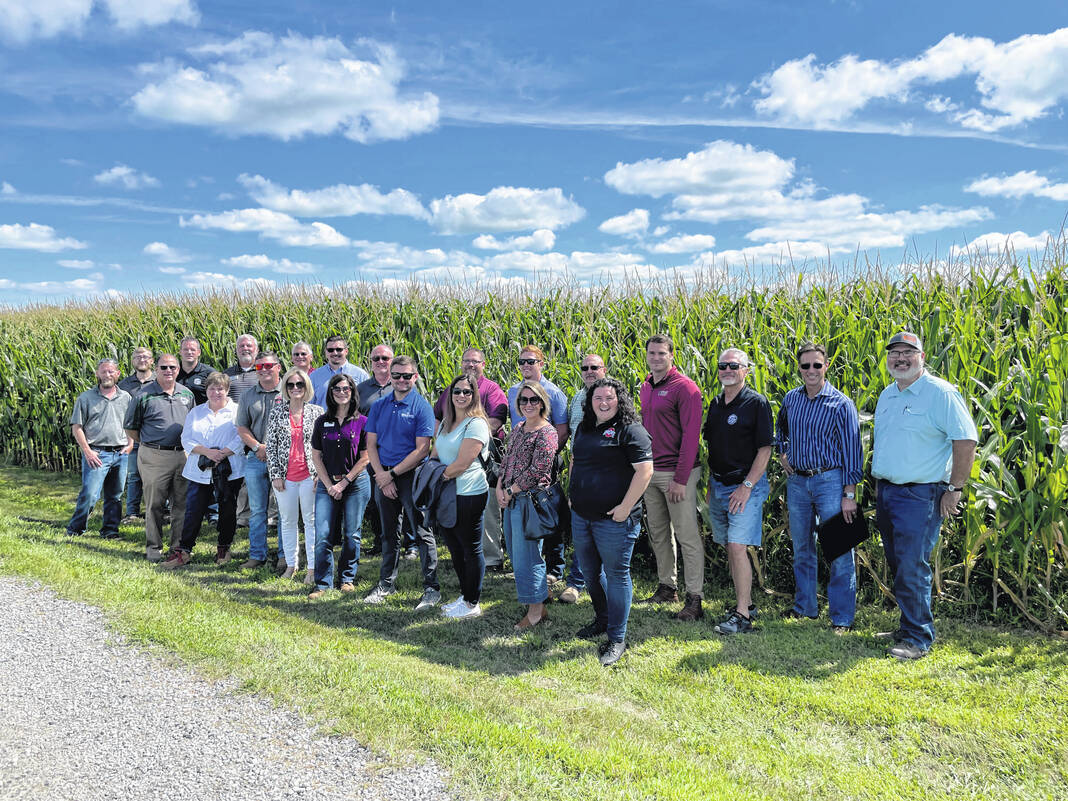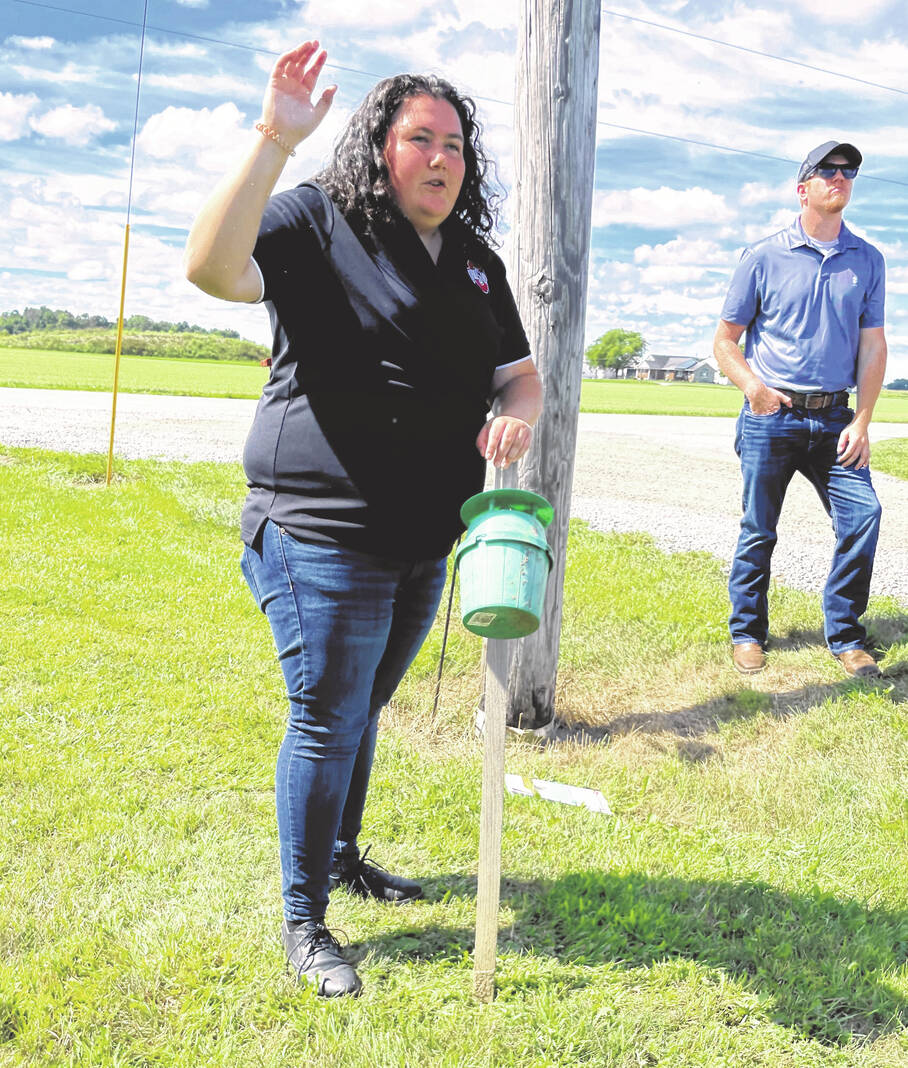
Elected officials attended the 2022 Farm Tour. The first stop included an over view of research and field data collection at the Schmitmeyer farm.
Meladi Brewer | Daily Advocate

Taylor Dill talked about western bean/cutworm trapping systems and spore traps.
Meladi Brewer | Daily Advocate
By Meladi Brewer
DailyAdvocate.com
VERSAILLES — The Darke County Chamber of Commerce hosted the 2022 Farm Tour on Friday.
The Darke County Chamber of Commerce Agriculture Committee, in cooperation with OSU Extension and Darke Soil and Water Conservation District hosted an elected officials Farm Tour on Friday, Aug. 12. Elected officials at the federal, state, and local levels were invited to attend this event.
“We have a strong agricultural community here in Darke County,” Darke Soil & Water Conservation District (DSWCD) Administrator, Jared Coppess said.
Darke County has approximately 344,000 acres of farmland with 96 percent being family owned farms. The Farm Tour was designed to showcase the agricultural conservation in the county and bring together the leaders in the community, as well as, present all the on-farm research going on to ensure the best crop and livestock production.
OSU Extension Agriculture & Natural Resources Educator for Darke County Taylor Dill gave a pre-tour speech regarding the economic impact of ag in Darke County; new data comes out every five years for agriculture.
“We are the ninth biggest area of land in the state, 92 percent of that land is tillable, and 96 percent of that land is owned by family farms. I find this to be a very impressive number for Darke County and for the United States in general,” Dill said.
Darke County’s statistics continued to impress as Ohio has ranked first in corn and soybean production, second in pork, egg, and meat production, fourth in cattle and calf production, and ninth in milking cows.
“We are the number one county in Ohio for corn and soybean production, so we are the number one agriculture crop state. We are also the number one ag receipts county as well,” Dill said.
$559 million in received in ag receipts and $379 million is from livestock. These receipts are defined as the gross income from sales of crops, livestock, and livestock products during the year.
“A good thing is, some of what we produce stays in Darke County. We may take it to a local feed mill and feed local animals with it, or we can take it nationally,” Dill said.
The local return to Darke County is $7.67 for every $1 invested. Darke County producers have received more than $300 million from USDA over the past 30 years through the DSWCD because for every dollar they receive from the county commissioners, it is matched by the increased amount. From there, DSWCD staff provide engineering, construction inspections, and compliance reviews to the local farmers.
“It is impressive that we are able to make a really big economic impact in our county and also affect the whole state and nation,” Dill said.
Two research and field data projects were presented on the tour at the Schmitmeyer farm. They included Western Bean/Cutworm trapping systems and spore traps. Dill has been utilizing the data in order to help farmers in different areas to better understand the dangers their crops face during the season.
“It is a really great system, and it is good that we know the numbers,” Dill said.
Farmers are able to view data and know if they need to spray certain pesticides or be aware of any diseases the spores have a potential of carrying during the season. By mitigating and controlling the pests and diseases, local investors do not have to worry about cross contamination.
“Work like this is very important, and it is impressive and fun that we get to bring this to our county first in order to pull the data from here and have an effect on the nation,” Dill said.
Tour goers were also introduced to the Darke County Airport Farm where installation of grassed waterways and conservation practices are taking place. The idea is to help water flow without access erosion and gullies being formed.
By controlling the surface flow, the soil is being protected from extreme erosion and ensures both the farm and those surrounding can continue to farm effectively and efficiently. Permanent vegetation will also be added at another date to also help with these issues.
One inch of rain is approximately 43,000 gallons per acre. By ensuring the water continuously flows instead of staying stagnant, farmers are taking care of their neighbors.
“You really want to know your neighbors and you want to work with them because you want that outlet because it will be how you get water away from your farm,” Coppess said.
When farmers come in wanting to do something, and they are on the upside of the watershed, sometimes the downstream farm will say they do not have a problem without realizing they are the outlet source. The DSWCD will help work as a mediary to help neighbors work with the group to address the problem.
“There was a program that talked about how we all live downstream of somebody, so what you do, impacts somebody downstream. People need to think about that because you are not only downstream of somebody, but there is somebody downstream of you,” Coppess said.
Coppess said he is excited for the waterway project and cannot wait to see the progress in the fall. Concluding the tour, guests enjoyed a lunch at Silas at the Hotel Versailles where they learned about all the locally sourced produce and meat that goes into preparing the dishes with the Executive Chef Aaron Allen. The lunch was sponsored by Edison State Community College and Phelan Insurance Agency, Inc.
To learn more about the OSU Extension visit darke.osu.edu, to learn about the Darke County Chamber of Commercevisti www.darkecountyohio.com, to learn about DSWCD visit www.darkeswcd.com, and to learn about Hotel Versailles, Silas and the 1819 room visit www.hotelversaillesohio.com.
To contact Daily Advocate Reporter Meladi Brewer, email [email protected].

